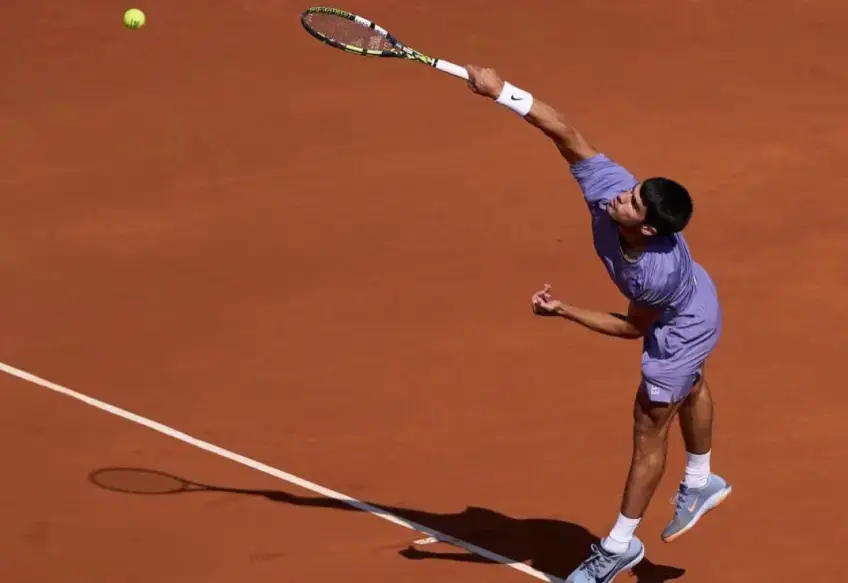In a fiery critique that has ignited debate across the tennis world, Italian tennis legend Adriano Panatta has called out world No. 3 Carlos Alcaraz for his relentless tournament schedule, suggesting it may be the root cause of his recent physical setbacks. The 1976 Roland Garros champion, known for his blunt commentary, made the remarks during a recent appearance on the Italian television show *La Domenica Sportiva*, following Alcaraz’s disappointing loss to Holger Rune in the Barcelona Open final on April 20, 2025. Panatta’s comments have added fuel to an ongoing discussion about the sustainability of modern tennis schedules, particularly for young stars like Alcaraz, who continue to push their physical limits in pursuit of greatness.
At just 21, Alcaraz has already cemented his status as one of tennis’s brightest talents, with four Grand Slam titles and six Masters 1000 trophies to his name. His 2025 season has been a mix of triumphs and challenges, with victories in Rotterdam and Monte Carlo but a recent straight-sets defeat to Rune, 7-6(6), 6-2, in Barcelona. Alcaraz, who reported a muscle issue during the match, has been vocal about the grueling nature of the extended Masters 1000 tournaments, which now span two weeks. “I read that the Spaniard complained that the Masters 1000 lasts two weeks, but let’s look carefully at his schedule,” Panatta remarked, pointing to Alcaraz’s decision to compete in Monte Carlo, Barcelona, and upcoming events in Madrid, Rome, and Paris without a break. “These guys never stop. Let’s think logically: Is it a problem of the calendar or a scheduling issue because he’s always playing?”
Panatta’s critique underscores the punishing demands of the ATP Tour, where top players face pressure to compete in a packed calendar of mandatory events. Alcaraz’s schedule, which includes three ATP 500 tournaments and multiple Masters 1000 events in 2025 alone, leaves little room for recovery. The Italian legend, who reached world No. 4 in 1976, argued that elite players should prioritize major tournaments to preserve their health and peak performance. “I believe the goal for tennis players at this level should be the four Grand Slams and then 7-8 other significant tournaments between the different Masters 1000s,” he said. “You can’t play every week at full intensity, even with a physique as incredible as Alcaraz’s.”
The Barcelona loss, where Alcaraz appeared hampered by discomfort, has raised concerns about his physical condition as the clay season intensifies. With the Madrid Open looming—where Alcaraz is set to face a yet-to-be-determined opponent on April 25, 2025—his team remains optimistic. A recent Instagram post from the Juan Carlos Ferrero Tennis Academy showed Alcaraz surrounded by his support staff, captioned, “Team Carlos Alcaraz is ready for Madrid.” Yet Panatta warned that the relentless pace could lead to further injuries, noting, “These players get hurt often because they hit so hard and move at sensational speeds.”
Panatta’s comments have sparked mixed reactions. Some fans agree that Alcaraz’s packed schedule, which includes 16 tournaments this season, risks burnout, especially given his history of injuries, such as a 2024 ankle sprain and forearm issues. Others argue that his ambition to compete at every opportunity reflects his hunger to dominate the sport. The debate touches on a broader issue: the ATP’s ranking system and mandatory event requirements, which Panatta has previously criticized for undervaluing Grand Slam success. Alcaraz, despite winning Roland Garros and Wimbledon in 2024, finished the year at No. 3 behind Alexander Zverev, a point of contention for the Italian.
As Alcaraz prepares for Madrid, the tennis world watches closely. Will the young Spaniard heed Panatta’s advice and adopt a more selective approach, or will he continue to chase every title, risking further strain? With the French Open on the horizon, where Alcaraz aims to defend his 2024 title, the stakes are higher than ever. For now, Panatta’s words serve as a stark reminder of the delicate balance between ambition and sustainability in the high-octane world of professional tennis.

